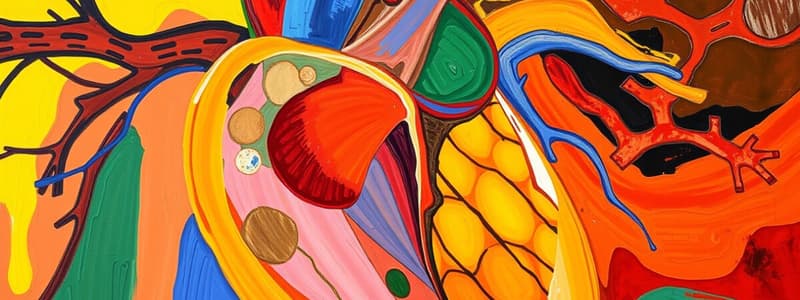Podcast
Questions and Answers
What is the main characteristic of the cardiac muscle's resting membrane potential (RMP)?
What is the main characteristic of the cardiac muscle's resting membrane potential (RMP)?
- It is stable at -90 mV. (correct)
- It is stable at +20 mV.
- It is unstable and changes continuously.
- It fluctuates between -30 mV and -60 mV.
During which phase of the nonpacemaker action potential does rapid depolarization occur due to Na+ influx?
During which phase of the nonpacemaker action potential does rapid depolarization occur due to Na+ influx?
- Phase 0 (correct)
- Phase 2
- Phase 3
- Phase 1
What causes the plateau phase during Phase 2 of the action potential?
What causes the plateau phase during Phase 2 of the action potential?
- Inactivation of Na+ channels.
- Excess Na+ influx through voltage-gated channels.
- Balance between Ca++ influx and K+ efflux. (correct)
- Rapid K+ efflux without Ca++ involvement.
What primarily restores the resting membrane potential after repolarization?
What primarily restores the resting membrane potential after repolarization?
Which of the following ions is found in higher concentration inside the cardiac muscle cell?
Which of the following ions is found in higher concentration inside the cardiac muscle cell?
What is the primary reason for the long absolute refractory period in cardiac muscle?
What is the primary reason for the long absolute refractory period in cardiac muscle?
Which phase of the cardiac action potential involves the initial repolarization?
Which phase of the cardiac action potential involves the initial repolarization?
What is the primary role of the inward rectifier potassium channels during resting phase?
What is the primary role of the inward rectifier potassium channels during resting phase?
What characterizes the fast sodium channels during the resting membrane potential?
What characterizes the fast sodium channels during the resting membrane potential?
What is the role of T-type calcium channels in pacemaker cells?
What is the role of T-type calcium channels in pacemaker cells?
What effect does digoxin have on cardiac cells?
What effect does digoxin have on cardiac cells?
What defines the difference between pacemaker action potentials and non-pacemaker action potentials?
What defines the difference between pacemaker action potentials and non-pacemaker action potentials?
What is the primary mechanism behind the rapid phase 0 depolarization in non-pacemaker action potentials?
What is the primary mechanism behind the rapid phase 0 depolarization in non-pacemaker action potentials?
Why is the resting membrane potential of pacemaker cells considered unstable?
Why is the resting membrane potential of pacemaker cells considered unstable?
What is the functionality of L-type calcium channels in cardiac muscle?
What is the functionality of L-type calcium channels in cardiac muscle?
What distinguishes non-pacemaker action potentials as 'fast response' potentials?
What distinguishes non-pacemaker action potentials as 'fast response' potentials?
Flashcards are hidden until you start studying
Study Notes
Excitability
- Defined as the ability of cardiac muscle to respond to stimuli.
- Membrane ion distribution is crucial for cardiac function.
Membrane Ion Distribution
-
Extracellular Fluid:
- Predominantly sodium (Na+) at 145 mM, calcium (Ca++) at 2.5 mM, minimal potassium (K+) at 4 mM, and chloride (Cl-) ions.
- Outer surface of the membrane is positively charged primarily due to sodium and calcium ions.
-
Intracellular Fluid:
- Mainly potassium (K+) at 150 mM, with large negatively charged organic anions (proteins, phosphates, sulfates), minimal sodium (20 mM), and chloride ions.
- Inner surface of the membrane is negatively charged due to these anions.
Cardiac Electrophysiology
Nonpacemaker Action Potential (Fast Response)
- Nonpacemaker cells include atrial, ventricular, and Purkinje fibers.
- Resting membrane potential (RMP) is stable at -90 mV.
- Phases of Action Potential:
- Phase 0 (Rapid Depolarization):
- Up to +20 mV due to rapid Na+ influx through fast voltage-gated sodium channels, lasting less than 2 msec (firing level at -60 mV).
- Phase 1 (Initial Repolarization):
- From +20 to +10 mV, due to Na+ channel inactivation and opening of transient outward potassium (K+) channels, lasting 2-3 msec.
- Phase 2 (Plateau Phase):
- From +10 to 0 mV, characterized by a balance between Ca++ influx (L-type calcium channels) and K+ efflux (delayed outward rectifier channels), lasting 200-300 msec. It significantly prolongs the action potential time and increases the absolute refractory period.
- Phase 3 (Repolarization):
- From 0 to -90 mV, due to Ca++ channel closure and K+ efflux through slow voltage-gated potassium channels, lasting 50-100 msec.
- Phase 4 (Resting Potential Restoration):
- At -90 mV, K+ efflux restores resting potential primarily via inward rectifier potassium channels, assisted by the Na+-K+ pump.
- Phase 0 (Rapid Depolarization):
Ion Channels
-
Sodium Channels:
- Fast channels allow rapid Na+ influx. An m-gate opens, while an h-gate closes, permitting a brief sodium entry (less than 1 msec).
- Slow channels (Na+-Ca++ exchanger) act as an antiporter, moving 3 sodium ions out for every calcium ion moved in.
-
Calcium Channels:
- L-type (Long-lasting):
- Present in both pacemaker and nonpacemaker cells, slowly inactivating, essential for action potential plateau and excitation-contraction coupling.
- T-type (Transient):
- Found in pacemaker cells, rapidly inactivating and involved in phase 4 depolarization.
- N-type (Neuronal):
- Restricted to nerve tissue.
- L-type (Long-lasting):
Cardiac Glycosides
- Digoxin is used in chronic heart failure cases, inhibiting Na+-K+ pumps.
- This process increases intracellular Na+ levels, which enhance Ca++ influx and cardiac contraction strength (positive inotropic effect).
Pacemaker Action Potential (Slow Response)
- Pacemaker cells are located in the SA and AV nodes.
- RMP ranges from -50 to -60 mV, characterized by higher permeability to Na+ than K+.
- During rest, there’s a Na+ influx (funny current), shifting the RMP from -60 to -50 mV, leading to eventual action potential firing.
Studying That Suits You
Use AI to generate personalized quizzes and flashcards to suit your learning preferences.




